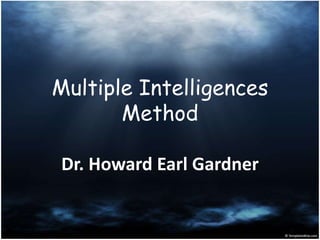
multipleintelligencesmethod.ppt
- 1. Multiple Intelligences Method Dr. Howard Earl Gardner
- 2. Inventor: Dr. Howard Earl Gardner. Country of Origin: USA Harvard University.
- 3. Theory of Language: • Language is seen not as an “added- on” and peripheral skill but as central to the whole life of the language learner and user. A multi- sensory view of language is required to build a theory of language, due to the context it provides for giving the message meaning and purpose.
- 4. Theory of Learning: • Students learn quickly when they use their special ability in language study and learning. Syllabus: these stages show the procedures used when teaching this method: – Stage 1. Awaken the Intelligence. By many extrasensory experiences, students discover the different properties of the objects and events of their environment. – Stage 2. Amplify the Intelligence. It can be strengthened by choosing and comparing the properties and contexts of experience of these events and objects have and provide.
- 5. Theory of Learning (2) – Stage 3. Teach with/for the Intelligence. The intelligence is linked to some aspect of language learning, via worksheets and small-group work. – -Stage 4. Transfer of the Intelligence. Students reflect what they learned in the previous stages and use them in the out-of- class world.
- 6. Dr. Gardner proposes eight different types of “intelligences”, which are seen as personal tools each individual possesses to make sense out of new information and to store it in such a way that it can be easily retrieved when needed for use: Theory of Learning (3)
- 7. Linguistic Explanation and understanding through the use of words. Visual Explanation and comprehension through the use of pictures, graphs, maps, etc. Body/Kinesthetic Ability to use the body to express ideas, accomplish tasks, create moods, etc. Interpersonal Ability to get along with others, work with others to accomplish tasks. Mathematical Use of logic and mathematical models to represent and work with ideas. Musical Ability to recognize and communicate using melody, rhythm, and harmony. Intrapersonal Learning through self-knowledge leading to understanding of motives, goals, strengths and weaknesses. Environmental Ability to recognize elements of the natural world around us and learn from them. Types of Intelligences
- 8. Role of the Teacher: Teachers become curriculum developers, lesson designers and analysts, activity finders or inventors, and, most critically, orchestrators of a rich array of multisensory activities within the realistic constraints of time, space, and resources of the classroom. Role of the Student: Students are active learners; they use their particular intelligences to gain knowledge, or experiment with each until they find to appropriate ones for them. Use of Mother Tongue: It is not used, but is not forbidden.
- 9. Materials: Linguistic Crosswords, newspapers, Internet, biographies, autobiographies, books. Visual Artwork, photographs, posters, charts, illustrations, cartoons, props for plays, videos, murals, sculptures. Body/Kinesthetic Games, experiments, pantomiming, presentations, dances, aerobics. Interpersonal Movies, team computer games, wrap arounds, conversations, conferences. Mathematical Puzzles, timelines, analogies, patterns, formulas, abstract symbols, diagrams, mind maps, computer games. Musical Background music, raps, jingles, tone patterns, trios/quartet, choirs, cheers. Intrapersonal Journals, readings, self evaluation. Environmental Elements found in nature.
- 10. Linguistic Speeches, story telling, written reports. Visual Poster making, use of overhead projector/ b-board. Body/Kinesthetic Role playing, co-operative learning. Interpersonal Co-operative tasks, class discussions, multiplayer games. Mathematical Problem solving, riddles. Musical Choral reading, lyric poems. Intrapersonal Poetry writing, goal setting, concentration exercises, meditations, silent reflection time. Environmental Outdoor education, nature walk, star gazing, exploring nature, environmental studies, field trips, bird watching, ecology studies, identifying leaves and rocks. Techniques:
- 11. Areas of language that are emphazised: All areas are developed, since working with the Multiple Intelligences requires the use of all skills.
- 12. Modes of Interaction Linguistic T-Ss, Ss-T Visual T-Ss, Ss-T, Ss-Ss Body/Kinesthetic Whole class, Ss-Ss, T-Ss Interpersonal Ss-T, T-Ss Mathematical Ss-T, T-Ss, Ss-Ss Musical Whole class, Ss-T, T-Ss Intrapersonal T-Ss, Ss-T Environmental Whole class, Ss-Ss, Ss-T
- 13. • Evaluation: The forms of Students’ Evaluation vary depending on the intelligence that is being worked. ♥ Students’ Feelings: Students’ feelings have a great importance; they receive a lot of encouragement to develop and use their particular intelligences. They feel confident, because they learn the language on their own way.
- 14. Advantages: • Students are likely to become more engaged in learning as they use learning modes that match their intelligence strengths. • Students' regular reflection on their learning broadens their definitions of effective and acceptable teaching and learning practices. • Students' increased engagement and success in learning stimulates teachers to raise their expectations, initiating a powerful expectation- response cycle that can lead to greater achievement levels for all.
- 15. Disadvantages: • Multiple intelligences interfere with each other if the class isn’t planned carefully and the activities are mixed up. • Some students might have trouble defining their strong Intelligences. • Sometimes, this method lacks support from parents and teachers, as they consider mathemathical and linguistic abilities worthier than any other ability.
- 16. A LESSON GUIDE ON SUGGESTOPEDIA APPROACH A. SUBJECT: B. GRADE LEVEL: C. TOPIC MATERIAL: D. OBJECTIVE: - Cognitive - Affective - Psychomotor E. METHOD: SUGGESTOPEDIA F. TEACHER – LEARNER INTERACTION G. POST ACTIVITY – (CONCLUDING PART)
- 17. A. TOPIC: B. GRADE LEVEL APPLIED FOR: C. NAME/TITLE OF STRATEGY: D. MATERIALS/PROPS NEEDED(IF ANY) E. PROCEDURES: